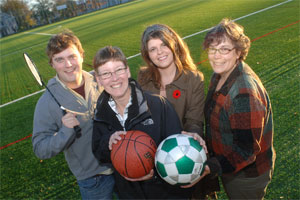 |
| Jordan Miller, Lori Livingston, Emma Smith and Susan Tirone are the authors of a Dal study exploring issues of participation in sports by new Canadians. (Danny Abriel photo.) |
Two new studies recommend national and local sport governing bodies do much more to encourage new Canadians to play sports and serve as coaches.
“Who’s responsible for getting immigrants involved – the immigrants themselves or the sports providers? Right now, the baseball falls between the two,” says Lori Livingston, one of the authors of the HÂţ» University study, "Engaging New Canadians in Coaching and the National Coaching Certification Program." The study’s other authors are professor Susan Tirone, master’s student Jordan Miller and recent graduate Emma Smith, now a research officer for Nova Scotia Government Employees Union.
The HÂţ» study took a qualitative approach — researchers did interviews in gyms and on sports fields throughout Halifax Regional Municipality. They talked to numerous immigrant newcomers and volunteers who work as sport leaders, coaches and administrators.
At the same time, a second study, this one undertaken by researchers at Queen’s University and the University of Alberta, used questionnaires to survey immigrant coaches about their personal experiences. The studies were commissioned by the Coaching Association of Canada and funded by RBC Financial Group.
Two studies, similar conclusionsÂ
Interestingly, even with different approaches, the two studies came to similar conclusions. Both studies found cost, language and difficulties acclimatizing to a new culture and way of life were major barriers to newcomers’ involvement in sports and coaching.
“Especially during the first years of transition, the cost can keep immigrants from getting involved or getting their children involved,” says Dr. Tirone, associate professor at HÂţ»â€™s School of Health and Human Performance. “The desire to have your children involved is strong, and yet it’s very costly.”
Which is not to say that sports organizations don’t offer financial breaks to families that need them, she notes. “They have supports in place, yet the immigrants don’t know about them.”
Language is another main difficulty, especially with sports that have their own terminology.
“On top of learning a new language, immigrants have to learn all this jargon that’s not part of their lexicon,” says Dr. Livingston. “It just makes it that much more difficult.”Â
On the other side, researchers found sports officials and coaches welcome the participation of immigrants, but being pressed to fill volunteer commitments, don’t have the time to actively encourage it. Some did not understand the challenges experienced by immigrant youth or cultural practices which may impede participation.
Dr. Tirone provides the example of older Muslim children who observe Ramadan by fasting in the daytime.
“If this is happening, it might be difficult for a child to play soccer during a game scheduled in the late afternoon,” she explains. “Coaches have to feel comfortable to discuss these matters with the parents. But often, they’re reluctant to address issues related to cultural diversity for fear they may offend.”
Recommendations for action
Based on the findings, researchers came up with seven recommendations for the Coaching Association of Canada. These include having sports governing bodies develop guidelines and policies to encourage more newcomers to take part in sports and coaching; developing and distributing information packages on coaching opportunities for new Canadians; holding community forums so coaches and athletes can share experiences; and having the National Coaching Certification Program (NCCP) develop a “sociology module” to enhance understanding about social conditions, including gender, ethnicity, race, religion and socio-economic status.
The soccer pitch, the basketball court and the local rink are ideal places for new and other Canadians to learn from each other, says Dr. Tirone. Participating in sports can ease the immigrant’s entry into their new home, help them develop social networks, improve their language skills and make new friends. But the benefits are two-way: Canadians stand to learn about other cultures, too. “The whole community is enriched,” she says.
